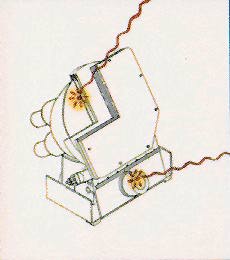
BATSE - the all-sky monitor for Compton is designed to detect gamma-ray bursts and search the sky for other transient emission.
BATSE the Burst and Transient Source Experiment -is the all-sky monitor for Compton. This experiment uses eight independent detectors, one at each corner of the satellite, resulting in a continuous view of those parts of the sky not blocked by the Earth. The individual modules use scintillators as the active detection element. Scintillators are large crystals, in the BATSE case made of sodium iodide, which convert the energy of the
gamma ray into visible light. Photomultipliers viewing the crystal then detect the visible photons. The strength of the resulting electronic signal is the record of the gamma-ray energy. BATSE can detect photons in the range of about 20 keV to 1 MeV. This instrument has the capability to detect many gamma rays in small periods of time, allowing scientists to study the temporal structure of gamma-ray bursts. While an individual BATSE module cannot record the direction of the incident gamma rays, the relative strengths of the burst signal in each module result in an approximate triangulation of the burst position. The origin of gamma-ray bursts remains the longest unsolved mystery in modern astronomy. Hundreds of gamma-ray bursts were detected prior to the launch of the Compton Gamma Ray Observatory, but few clues to their nature have been forthcoming. One of BATSE's primary objectives is to study these sources by mapping their positions on the sky and by measuring their